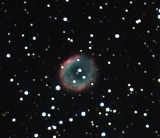
NGC 2438
Encyclopedia
NGC 2438 is a planetary nebula
about 3,000 light years
away in the constellation
Puppis
. It was discovered by William Herschel
on March 19, 1786.
The planetary nebula
NGC 2438 appears to lie within the cluster M46
, but it is most likely unrelated since it does not share the cluster's radial velocity. The case is yet another example of a superposed pair, joining the famed case of NGC 2818
.
Long exposures have shown that this planetary nebula has an extended halo
, while the more easily visible portion probably dates to the death of the red giant
in its center.
of this planetary nebula is a 17.7-magnitude
white dwarf
, with surface temperature of about 75000 kelvins (74,726.9 °C). It's one of the hottest stars known.
Planetary nebula
A planetary nebula is an emission nebula consisting of an expanding glowing shell of ionized gas ejected during the asymptotic giant branch phase of certain types of stars late in their life...
about 3,000 light years
Light Years
Light Years is the seventh studio album by Australian recording artist Kylie Minogue. It was released on 25 September 2000 by Parlophone and Mushroom Records. The album's style was indicative of her return to "mainstream pop dance tunes"....
away in the constellation
Constellation
In modern astronomy, a constellation is an internationally defined area of the celestial sphere. These areas are grouped around asterisms, patterns formed by prominent stars within apparent proximity to one another on Earth's night sky....
Puppis
Puppis
Puppis is a constellation in the southern sky. Its name is the Latin word for the poop deck of a ship, and Puppis represents the deck of the ship and its deckhouses...
. It was discovered by William Herschel
William Herschel
Sir Frederick William Herschel, KH, FRS, German: Friedrich Wilhelm Herschel was a German-born British astronomer, technical expert, and composer. Born in Hanover, Wilhelm first followed his father into the Military Band of Hanover, but emigrated to Britain at age 19...
on March 19, 1786.
The planetary nebula
Planetary nebula
A planetary nebula is an emission nebula consisting of an expanding glowing shell of ionized gas ejected during the asymptotic giant branch phase of certain types of stars late in their life...
NGC 2438 appears to lie within the cluster M46
Messier 46
Messier 46 is an open cluster in the constellation of Puppis. It was discovered by Charles Messier in 1771...
, but it is most likely unrelated since it does not share the cluster's radial velocity. The case is yet another example of a superposed pair, joining the famed case of NGC 2818
NGC 2818
NGC 2818 is a planetary nebula located in the southern constellation Pyxis . This spectacular nebula consists largely of glowing gases from the star's outer layers ejected during the final stages of its life when it had run out of the fuel necessary to sustain its core fusion processes...
.
Long exposures have shown that this planetary nebula has an extended halo
Galactic halo
The term galactic halo is used to denote an extended, roughly spherical component of a galaxy, which extends beyond the main, visible component. It can refer to any of several distinct components which share these properties:* the galactic spheroid...
, while the more easily visible portion probably dates to the death of the red giant
Red giant
A red giant is a luminous giant star of low or intermediate mass in a late phase of stellar evolution. The outer atmosphere is inflated and tenuous, making the radius immense and the surface temperature low, somewhere from 5,000 K and lower...
in its center.
Central star
The central starWhite dwarf
A white dwarf, also called a degenerate dwarf, is a small star composed mostly of electron-degenerate matter. They are very dense; a white dwarf's mass is comparable to that of the Sun and its volume is comparable to that of the Earth. Its faint luminosity comes from the emission of stored...
of this planetary nebula is a 17.7-magnitude
Apparent magnitude
The apparent magnitude of a celestial body is a measure of its brightness as seen by an observer on Earth, adjusted to the value it would have in the absence of the atmosphere...
white dwarf
White dwarf
A white dwarf, also called a degenerate dwarf, is a small star composed mostly of electron-degenerate matter. They are very dense; a white dwarf's mass is comparable to that of the Sun and its volume is comparable to that of the Earth. Its faint luminosity comes from the emission of stored...
, with surface temperature of about 75000 kelvins (74,726.9 °C). It's one of the hottest stars known.

